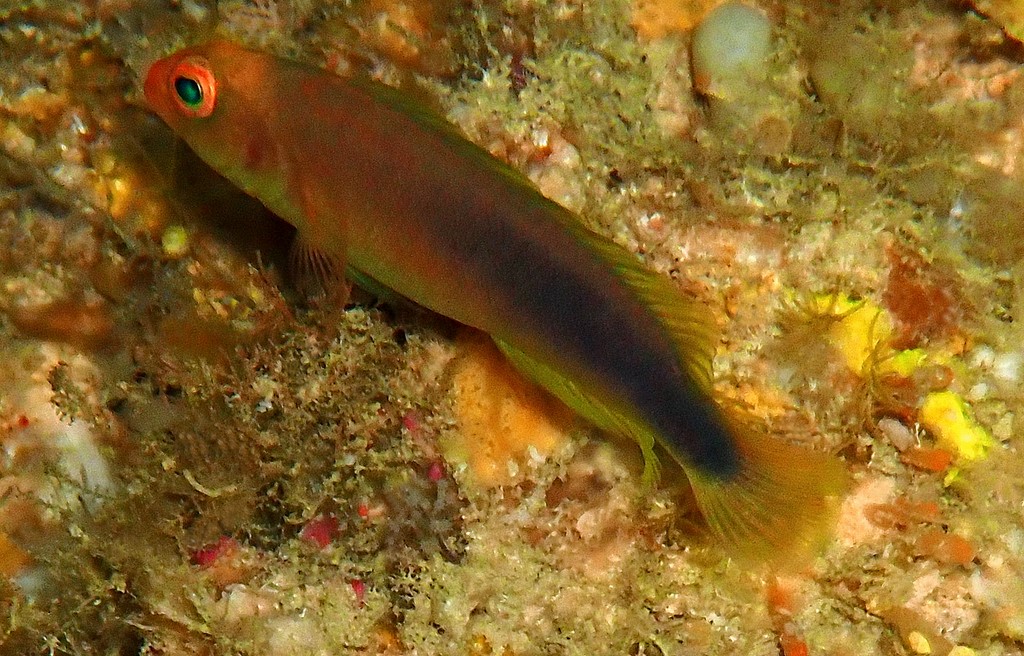PSEUDOCHROMIS FLAMMICAUDA - (LUBBOCK & GOLDMAN, 1976)
Picture courtesy of: Alain Daoulas
Actinopterygii (Gigaclass) > Actinopteri (Class) > Teleostei (Subclass) > Blenniiformes (Order) > Pseudochromidae (Family) > Pseudochrominae (Subfamily) > Pseudochromis (Genus)
Firetail dottyback, Orangetail dottyback, Orange-tail dottyback, 焰尾拟雀鲷,
Description
Dorsal spines (total): 3; Dorsal soft rays (total): 23-25, last: 15-25 segmented rays branched (all or all but first branched in specimens larger than 22 mm SL); Anal spines: 3; Anal soft rays: 13-14, all or all but first segmented rays branched; Pectoral fin rays: 17-19; Pelvic fin rays: I, 5; Scales in lateral line series: 36-40; Anterior lateral line scales: 24-30; Posterior lateral line scales: 4-10 + 0; Circumpeduncular scales: 17-20; Gill rakers: 4-6 + 10-12 = 14-18; Upper procurrent caudal-fin rays: 6-7; Lower procurrent caudal-fin rays: 5-7; Total caudal-fin rays 28-31. Max. length: 5.5 cm TL. Depth range: 2 - 25 m, usually: 3 - 10 m.
Color
Etymology
Pseudochromis: from Greek, pseudes = false + from Greek, chroemo = to neigh. A name dating to Aristotle, referring to a drum (Sciaenidae) and its ability to make noise; Later applied to this damselfish and subsequently expanded to embrace dottybacks, cichlids and wrasses (all perch-like fishes once thought to be related).
flammicauda: from Latin, flammeus = fiery red + from Latin, cauda = tail. Reffering to the brigh red caudal fin of the male of the species.
Original description: Pseudochromis flammicauda Lubbock & Goldman, 1976 - Type locality: One Tree Island, Capricorn Group, Great Barrier Reef, Australia.
Distribution
Eastern Australia: Great Barrier Reef, Queensland (Australia), reefs in the Coral Sea and New Caledonia (Koumac).
Biology
Occurs inshore. Found in or near holes of coral or rock. Aquarium fish (uncommon).
Last update: 4, March 2023
Actinopterygii (Gigaclass) > Actinopteri (Class) > Teleostei (Subclass) > Blenniiformes (Order) > Pseudochromidae (Family) > Pseudochrominae (Subfamily) > Pseudochromis (Genus)
Firetail dottyback, Orangetail dottyback, Orange-tail dottyback, 焰尾拟雀鲷,
Description
Dorsal spines (total): 3; Dorsal soft rays (total): 23-25, last: 15-25 segmented rays branched (all or all but first branched in specimens larger than 22 mm SL); Anal spines: 3; Anal soft rays: 13-14, all or all but first segmented rays branched; Pectoral fin rays: 17-19; Pelvic fin rays: I, 5; Scales in lateral line series: 36-40; Anterior lateral line scales: 24-30; Posterior lateral line scales: 4-10 + 0; Circumpeduncular scales: 17-20; Gill rakers: 4-6 + 10-12 = 14-18; Upper procurrent caudal-fin rays: 6-7; Lower procurrent caudal-fin rays: 5-7; Total caudal-fin rays 28-31. Max. length: 5.5 cm TL. Depth range: 2 - 25 m, usually: 3 - 10 m.
Color
- Females: head and body dark grey-brown, paler ventrally; Iris pale yellow with blue suboval ring around pupil; Basal portion of dorsal fin dark grey, remainder of fin dusky hyaline to hyaline; Anal fin greyish hyaline to dark grey basally, remainder of fin dusky hyaline to hyaline; Basal two-thirds of caudal fin grey to bright yellow, remainder of fin greyish to yellowish hyaline; Pectoral fins hyaline; Pelvic fins hyaline, sometimes grey basally.
- Males: head and body anterior to vertical to oblique line passing through pectoral-fin base pale pinkish yellow to bright orange-yellow; Iris orange to bright red with blue suboval ring around pupil; Remainder of body dark blue to dark grey, with triangular expansion of this coloration onto base of caudal fin; Upper and lower edges of posterior part of caudal peduncle bright orange-yellow; Basal half of dorsal fin dark blue to dark grey, remainder of fin bluish hyaline to hyaline; Dorsal fin with two narrow pink to orange-red stripes, one passing through middle and other along distal edge ofdark basal portion of fin; Basal part of anal fin blue to dark grey, remainder of fin pinkish or bluish hyaline to hyaline, two areas separated by pink to bright red stripe; Caudal fin where adjacent to triangular dark blue to dark grey basal mark bright orange-yellow to bright orange, remainder of fin bright yellow, becoming yellowish hyaline posteriorly; Pectoral fins pinkish hyaline to hyaline; Pelvic fins pale pink to pinkish hyaline.
Etymology
Pseudochromis: from Greek, pseudes = false + from Greek, chroemo = to neigh. A name dating to Aristotle, referring to a drum (Sciaenidae) and its ability to make noise; Later applied to this damselfish and subsequently expanded to embrace dottybacks, cichlids and wrasses (all perch-like fishes once thought to be related).
flammicauda: from Latin, flammeus = fiery red + from Latin, cauda = tail. Reffering to the brigh red caudal fin of the male of the species.
Original description: Pseudochromis flammicauda Lubbock & Goldman, 1976 - Type locality: One Tree Island, Capricorn Group, Great Barrier Reef, Australia.
Distribution
Eastern Australia: Great Barrier Reef, Queensland (Australia), reefs in the Coral Sea and New Caledonia (Koumac).
Biology
Occurs inshore. Found in or near holes of coral or rock. Aquarium fish (uncommon).
Last update: 4, March 2023
